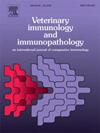减毒但没有毒性的伪狂犬病毒激活猪骨髓来源的树突状细胞
IF 1.4
3区 农林科学
Q4 IMMUNOLOGY
引用次数: 0
摘要
伪狂犬病毒(PrV)是奥杰斯基氏病的病原体,它继续给整个东南亚的养猪生产者造成经济损失。通过接种减毒活疫苗(例如Bartha K61毒株)来控制PrV,该毒株也显示出作为病毒载体的希望。尽管PrV减毒活疫苗取得了成功,而且它们被改造为疫苗载体,但了解其免疫原性基础的研究很少。本研究通过FLT3-L培养分化猪骨髓源性树突状细胞(BMDC),产生8个不同表达CADM1、CD172a、CD14、CD163和CD11c的骨髓细胞群,包括CADM1高常规(c)DC和CD14+ DC。用表达gfp的PrV菌株Bartha K61和强毒的Kaplan体外感染BMDC,发现Bartha K61的感染速度更快。与PrV Kaplan感染相比,Bartha K61感染后,感染者和旁观者BMDC人群中成熟标志物(MHC II类和CD80/86)的表达也有所增加。这伴随着细胞因子反应的增加。与cDC和CD14+ DC亚群相关的IL-12和TNF的产生表明,这些细胞的感染可能是与PrV Bartha K61疫苗相关的强效免疫原性的关键。本文章由计算机程序翻译,如有差异,请以英文原文为准。
Attenuated but not virulent pseudorabies virus activates porcine bone marrow-derived dendritic cells
Pseudorabies viruses (PrV), the causative agent of Aujeszky’s disease, continues to cause economic losses to pig producers across Southeast Asia. PrV is controlled by vaccination with live attenuated vaccines, such as the Bartha K61 strain, which has also shown promise as a viral vector. Despite the success of live attenuated PrV vaccines and their utility to be engineered as vaccine vectors, studies to understand the basis of their immunogenicity are scarce. Here, porcine bone marrow-derived dendritic cells (BMDC) were differentiated by culture with FLT3-L, generating eight myeloid cell populations differing in CADM1, CD172a, CD14, CD163 and CD11c expression, and included CADM1high conventional (c)DC and CD14+ DC. In vitro infection of BMDC with GFP-expressing PrV strains Bartha K61 and virulent Kaplan revealed a more rapid infection with Bartha K61. Compared to PrV Kaplan infection, there was also an increase in maturation marker expression (MHC class II and CD80/86) in both infected and bystander BMDC populations following Bartha K61 infection. This was accompanied by a concomitant increased cytokine response. IL-12 and TNF production associated with the cDC and CD14+ DC subsets, suggests that infection of these cells may be key to the potent immunogenicity associated with PrV Bartha K61 vaccination.
求助全文
通过发布文献求助,成功后即可免费获取论文全文。
去求助
来源期刊
CiteScore
3.40
自引率
5.60%
发文量
79
审稿时长
70 days
期刊介绍:
The journal reports basic, comparative and clinical immunology as they pertain to the animal species designated here: livestock, poultry, and fish species that are major food animals and companion animals such as cats, dogs, horses and camels, and wildlife species that act as reservoirs for food, companion or human infectious diseases, or as models for human disease.
Rodent models of infectious diseases that are of importance in the animal species indicated above,when the disease requires a level of containment that is not readily available for larger animal experimentation (ABSL3), will be considered. Papers on rabbits, lizards, guinea pigs, badgers, armadillos, elephants, antelope, and buffalo will be reviewed if the research advances our fundamental understanding of immunology, or if they act as a reservoir of infectious disease for the primary animal species designated above, or for humans. Manuscripts employing other species will be reviewed if justified as fitting into the categories above.
The following topics are appropriate: biology of cells and mechanisms of the immune system, immunochemistry, immunodeficiencies, immunodiagnosis, immunogenetics, immunopathology, immunology of infectious disease and tumors, immunoprophylaxis including vaccine development and delivery, immunological aspects of pregnancy including passive immunity, autoimmuity, neuroimmunology, and transplanatation immunology. Manuscripts that describe new genes and development of tools such as monoclonal antibodies are also of interest when part of a larger biological study. Studies employing extracts or constituents (plant extracts, feed additives or microbiome) must be sufficiently defined to be reproduced in other laboratories and also provide evidence for possible mechanisms and not simply show an effect on the immune system.

 求助内容:
求助内容: 应助结果提醒方式:
应助结果提醒方式:


